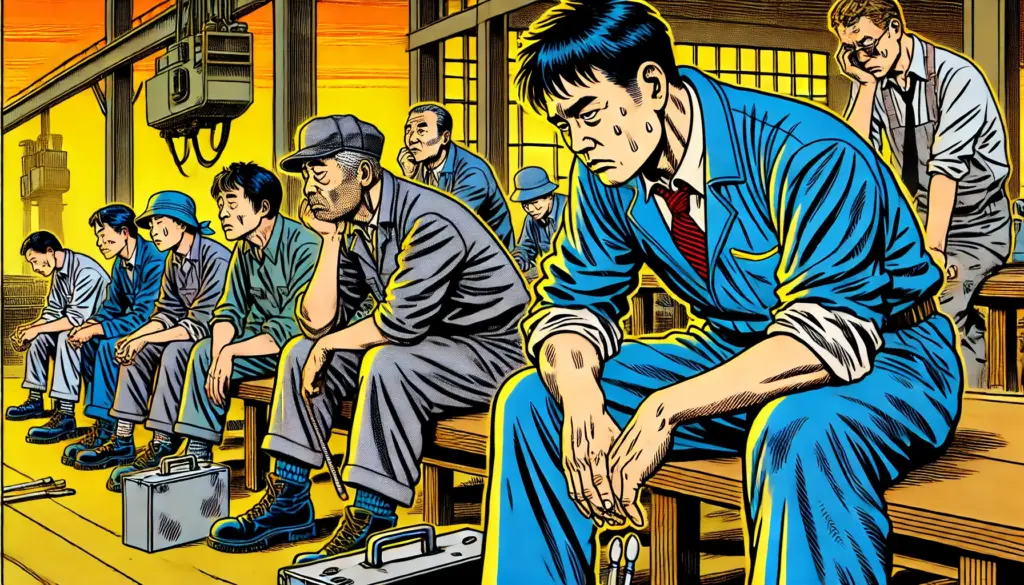
In Japan, the term “3K” is widely used to describe jobs that are considered undesirable because they are kitsui (きつい: tough), kitanai (汚い: dirty), and kiken (危険: dangerous).
This phrase became common during the late 1980s economic bubble, when young people gravitated toward corporate and office jobs, leaving physically demanding roles behind.
Although often undervalued, these jobs are essential to society. From maintaining infrastructure to caring for the elderly, 3K work ensures the daily functioning of Japan. Yet, stigma, poor working conditions, and low pay have made them the least sought-after roles in the labor market.
Understanding the “3K” Concept
Origins of the Term
The idea of labeling tough jobs with an acronym did not start in Japan—there is a similar Western term called “3D jobs”: dirty, dangerous, and demeaning. However, the Japanese version reflects the language and cultural nuances of the domestic labor market. While “3D” focuses on how others see the job, “3K” reflects how workers themselves experience it—physically exhausting, unpleasant, and risky.
Examples of 3K Jobs in Japan
Common examples include:
- Construction work: Heavy lifting, exposure to weather, and accident risks.
- Cleaning and sanitation: Dealing with waste, hazardous substances, and unpleasant odors.
- Elderly caregiving: Physically taxing, emotionally draining, and sometimes dangerous when handling patients.
- Factory work: Long hours, repetitive motions, and machinery hazards.
- Certain healthcare roles: Emergency care, handling infectious diseases, and late-night shifts.
Who Works in 3K Jobs?
Japanese Workers Who Have Few Alternatives
Some Japanese workers enter 3K jobs because they lack academic qualifications or opportunities in more prestigious fields. Others inherit family businesses in construction or manufacturing. For them, 3K jobs are not just a necessity—they are a tradition.
Foreign Workers Filling the Gap
Japan’s aging population and declining birthrate have created severe labor shortages. As a result, the country has increasingly relied on foreign workers—especially those from Southeast Asia and South America—to fill roles in construction, manufacturing, and caregiving. Many arrive under government programs such as the Technical Intern Training Program, which provides work opportunities but has also faced criticism for labor exploitation.
Marginalized Communities
Historically, certain marginalized groups in Japan, such as the Burakumin, were limited to socially devalued work. While legal discrimination has ended, some patterns in job distribution still reflect old prejudices.
The Reality of Working Conditions
Physical Strain and Health Risks
3K jobs often involve heavy lifting, repetitive movements, or constant standing. Workers in these fields may suffer from chronic back pain, joint problems, and fatigue. In industries like construction and manufacturing, there’s also a real risk of workplace accidents.
Low Pay and Limited Career Growth
Despite the difficulty and importance of the work, wages in 3K industries are often lower than those in white-collar sectors. Promotion opportunities are limited, and many roles are tied to temporary or contract-based employment.
Long Hours and Poor Work-Life Balance
In caregiving, nursing, and construction, it’s common for workers to have irregular hours or be on call. This leads to fatigue, burnout, and reduced time for family and personal life.
Expanding Beyond 3K: New Terms for Harsh Work
6K – The Modern Expansion
The “6K” label adds three more hardships: cannot go home, strict rules, and low pay. These reflect the reality of long hours, rigid workplace structures, and inadequate compensation—especially in caregiving and factory jobs.
“New 3K” – White-Collar Burnout
Interestingly, Japanese office workers have adopted the term “new 3K” to describe modern corporate misery: hard workload, no time to leave, and low salary. This shows that mental strain in white-collar jobs can rival the physical strain of blue-collar work.
5K or 9K in Nursing
Healthcare professionals, particularly nurses, face multiple hardships—ranging from the original 3K to additional challenges like emotional exhaustion, personal health problems, delayed life milestones, and insufficient support systems.
Why These Jobs Persist Despite the Challenges
Economic Necessity
Many workers, both Japanese and foreign, take on 3K jobs because they offer immediate income without requiring advanced qualifications.
Pride in Craft and Contribution
Some workers take pride in the essential nature of their jobs. Construction workers, for example, see their work reflected in the city skyline; caregivers find meaning in improving people’s lives.
Limited Alternative Opportunities
For those without higher education or specialized skills, 3K work may be the most accessible employment option.
My Perspective: Redefining the Value of 3K Jobs
💡 If Japan wants to address labor shortages and improve societal well-being, it needs to reframe how these jobs are perceived and rewarded.
- Increase Wages and Benefits – Better pay and comprehensive health coverage would make 3K roles more competitive.
- Improve Safety Standards – Investments in modern equipment and strict enforcement of workplace safety could reduce accident risks.
- Promote Cultural Inclusion – As foreign workers take on a growing share of these jobs, language support and cross-cultural training can improve workplace harmony.
- Change Public Perception – Media and education should emphasize that 3K jobs are indispensable, not inferior.
- Address Overwork – Both blue- and white-collar sectors need better work-hour regulations to prevent burnout.
Final Thoughts
3K jobs—tough, dirty, and dangerous—form the foundation of Japan’s economy and daily life. Yet, their workers often face low pay, harsh conditions, and societal stigma. Expanding the conversation to include 6K, new 3K, and 9K terms reminds us that hardship is not limited to physical labor.
Japan’s challenge is clear: improve working conditions, value these essential roles, and create a labor environment where dignity and safety are guaranteed—no matter how difficult the work.



















































